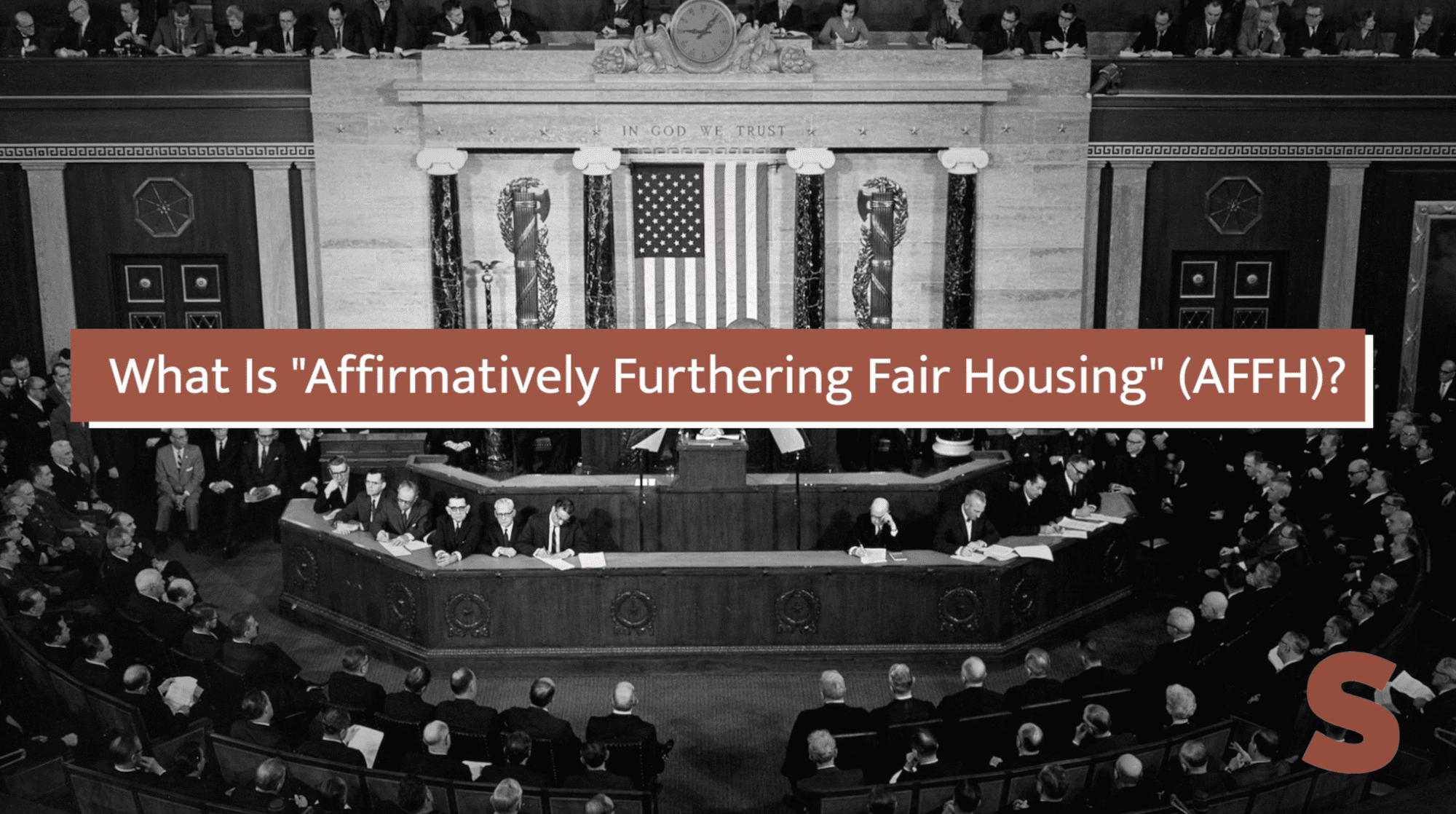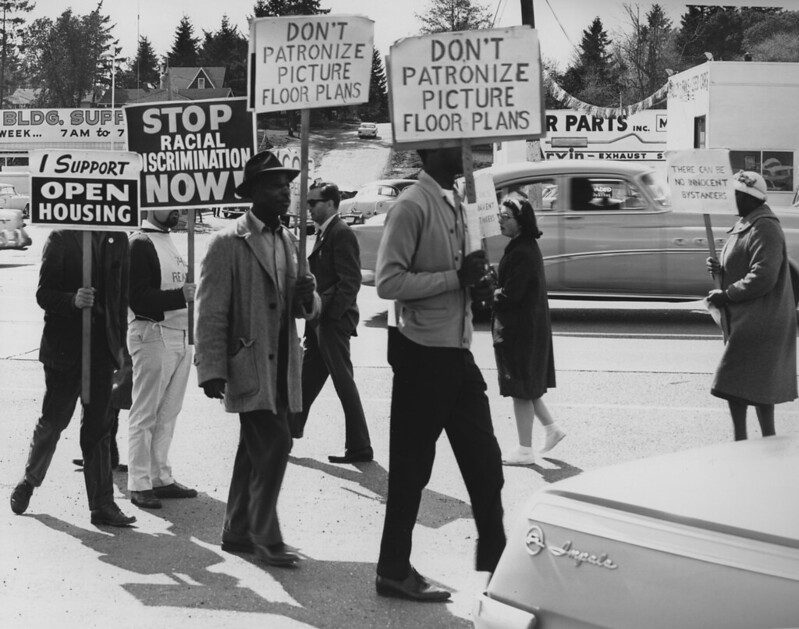This article is part of the Under the Lens series
New AFFH Rules: What You Need to Know

The grand prize winner for 2022 in the Fair Housing Council of Oregon’s annual poster contest for Oregon students in grades 1-8. Artwork by Bayalyn Stack and Kira Fryer. Image courtesy of the Fair Housing Council of Oregon
Woven into Oregon’s land use and housing production policies is an obligation for all cities with at least 10,000 residents to affirmatively further fair housing (AFFH). This means that cities, even the smaller ones, must take steps to address issues like segregation and disparities in access to housing.
Although AFFH is a federal requirement, fair housing advocates in Oregon believed that inserting AFFH into state policy would ensure that municipalities continue to respond to fair housing issues even if changes are implemented at the federal level. (As they were when President Donald Trump was in office.)
The process that led to the inclusion of AFFH in Oregon’s state policy began in 2019 with the approval of a bill that aimed to reform the way jurisdictions plan for the housing needs of residents at every income level. Championed by former Oregon speaker of the house Tina Kotek, who is now governor, House Bill 2003 launched three initiatives:
- It directed Oregon Housing and Community Services (OHCS) and the Department of Land Conservation and Development (DLCD) to pilot a statewide methodology for municipalities to calculate the number of units needed to meet the current and future housing needs of all residents. That methodology, now called the Oregon Housing Needs Analysis, applies to municipalities with at least 10,000 residents.
- It directed DLCD to adopt a schedule for those cities to update their housing needs analysis. Cities within the Portland Metro region must update their analysis every six years; cities outside the region must make updates every eight years.
- It required that these cities approve a housing production strategy one year after their housing needs analysis is adopted. The strategy must outline a list of specific tools, actions, and policies that the city plans to use to address the housing needs identified in their analysis.
HB 2003 was inspired in part by California, which has had a system in place since 1969 for determining housing needs within jurisdictions, as well as a requirement that cities periodically update their housing plans to address how they will meet those needs.
In 2020, Oregon’s DLCD began the rulemaking process to develop procedures that would help cities comply with the requirements of the bill. During the same time, racial justice protests surged across the state and nation, and the relationship between racial injustice, housing insecurity, and fair housing became even more apparent. Oregon advocates seized the opportunity to incorporate fair housing into the machinery of land use planning in Oregon.
Fair housing advocates also witnessed how federal AFFH rules could be reinterpreted by the Executive Branch. In July 2020, Trump suspended the federal AFFH housing rule and replaced fair housing policies with ones that were contrary to the spirit of the Fair Housing Act.
“It’s been amazing to see our state embrace fair housing principles, and particularly affirmatively furthering fair housing, in the work being done to plan for housing to meet the needs of every person in Oregon,” says Allan Lazo, executive director of the Fair Housing Council of Oregon, a statewide civil rights organization. Lazo is also a member of the Land Conservation and Development Commission, Oregon’s statewide land use policy-setting body, and HB 2003’s rulemaking committees and workgroups. “Oregon’s land use planning system has for decades, through Statewide Planning Goal 10, strived to meet the housing needs of every Oregon resident, and by adding consideration of affirmatively furthering fair housing, we can better work toward fair and equitable housing outcomes.”
[RELATED ARTICLE: Racial Equity, Housing, and COVID]
Oregon’s rulemaking process also provided an opportunity to clarify and integrate AFFH obligations to smaller cities that do not receive direct appropriations of federal housing and community development funding and are thus not subject to federal AFFH requirements. Finally, incorporating AFFH in statewide planning policy provided an opening to explore how land use and housing planning could get at segregated housing patterns, promote the availability of physically accessible housing, and support fairer geographic access to opportunity in Oregon communities.
Advocates like Fair Housing Council of Oregon and Housing Land Advocates, an advocacy group that focuses on land use planning and housing policy, primed the pump to incorporate AFFH into state policy. “We had been exploring ways to connect housing and land use planning to promote AFFH for a decade or more through conferences, speaking engagements, and law review articles,” says Jennifer Bragar, president of Housing Land Advocates.
Fair housing advocates recommended that the definition of AFFH in Oregon’s state rules be modeled on the 2015 federal definition promulgated during the Obama administration. Currently, it reads as follows:
Affirmatively furthering fair housing means addressing disproportionate housing needs, patterns of integration and segregation, racially or ethnically concentrated areas of poverty, and disparities in access to housing opportunity.
Anyeley Hallová, chair of the Land Conservation and Development Commission, recommended that cities address how their proposed housing production strategies will result in fair and equitable housing outcomes with regard to six factors:
- location of housing,
- fair housing,
- housing choice,
- housing options for community members experiencing homelessness,
- affordable homeownership and affordable rental housing,
- and gentrification, displacement, and housing stability.
With Hallová as its champion, fair and equitable housing became part of state housing policy in early 2021.
“When Commissioner Lazo and I were sitting on the Housing Production Strategy Rulemaking Committee in 2020, we had a federal administration that did not support AFFH,” says Hallová. “Fair and affordable housing is an important value in all circumstances. Given this, we thought it important to include the AFFH definition and concept into the Oregon Administrative Rules. Thankfully, our current federal administration has come back to advancing AFFH. Our inclusion of the definition and concept in state rules positions Oregon as a national leader in this regard.”
The Oregon Legislature directed DLCD and OHCS to deliver recommendations on how to implement the Oregon Housing Needs Analysis in advance of the 2023 legislative session. OHCS and DLCD submitted a legislative report in December 2022 outlining recommendations for comprehensive, system-wide reforms. If implemented, these reforms would reverse decades of underinvestment in housing production and development readiness, organize land use planning systems toward the common goal of building housing, and begin to redress disparities in housing outcomes. House Bill 2889, the policy vehicle for implementing these reforms, is now before the Oregon legislature and has been rolled into HB 2001, an omnibus housing bill.
Next Steps for Oregon
Getting AFFH into the state’s land use policy was the first step. As cities are in the first year of the program, DLCD is now taking the next step, which is to develop additional guidance for municipalities on how to make headway on their obligation to create fair and equitable housing outcomes.
DLCD has contracted with my company, Commonworks Consulting, and the Fair Housing Council of Oregon to develop the guide. The guidebook will likely recommend that cities start by identifying local fair housing issues. Like the proposed new federal AFFH rule, Oregon’s approach will be to keep the analysis relatively straightforward and focus on meaningful actions to promote housing production, affordability, and choice.
The guidebook will likely provide assistance on how cities can address these issues as part of their housing production strategy. Our guidebook will include actions, promising practices, and examples matched to solving specific fair housing issues, taking into account the size and capacity of the local jurisdiction. Once again, Oregon is likely to draw on California’s experience, and also the State of Washington, which recently passed its own AFFH-related provisions. The California Department of Housing and Community Development issued AFFH guidance in April 2021, and the Association of Bay Area Governments produced an AFFH Policies and Program Toolkit in September 2022. In 2021, the Washington State legislature amended its Growth Management Act to require that cities examine racially disparate impacts, exclusion, and displacement risk in their housing regulations and adopt policies to begin to undo the impacts. The state has also issued draft guidance.
As Lazo of the Fair Housing Council of Oregon says, “We know that we can create greater access to opportunity for every person in Oregon when cities across our state are held accountable for ensuring intentional efforts that not only increase the production of much-needed housing, but also assess whether everyone has true housing choice in every community in Oregon.”
Editor’s note: As of April 6, the comment period for the proposed new federal AFFH rule has been extended. Comments should be received on or before April 24.
|
|





Thanks for the article. I have two questions about enforcement. What happens if a city’s housing production strategy is not deemed to be adequate? What happens if the city’s housing strategy doesn’t produce enough affordable housing units?
Peter, working out the details of enforcement has been a long process. One of the challenges has been to provide a way to separate cities just needing help and money from cities that are just plain bad actors. Today the Governor is signing into law a bill that provides for “progressive enforcement.” The state will maintain a Production Dashboard and Equity Indicators measuring the progress of each city annually. Halfway into a city’s implementation period, the state assesses a city’s progress, taking into account a variety of factors. If they are underperforming relative to their peers, they are referred to a “Housing Acceleration Program” that includes an audit of their processes and a negotiated agreement around what the city will do going forward. The city may receive technical assistance and funding as a result of this. If the city fails to follow the agreement, the law provides for harsher penalties, including imposing models on the city or actually implementing elements of the agreement in the city’s behalf. If you’d like to see the details, look at Sections 14 to 19 of https://olis.oregonlegislature.gov/liz/2023R1/Downloads/MeasureDocument/HB2001/Enrolled .